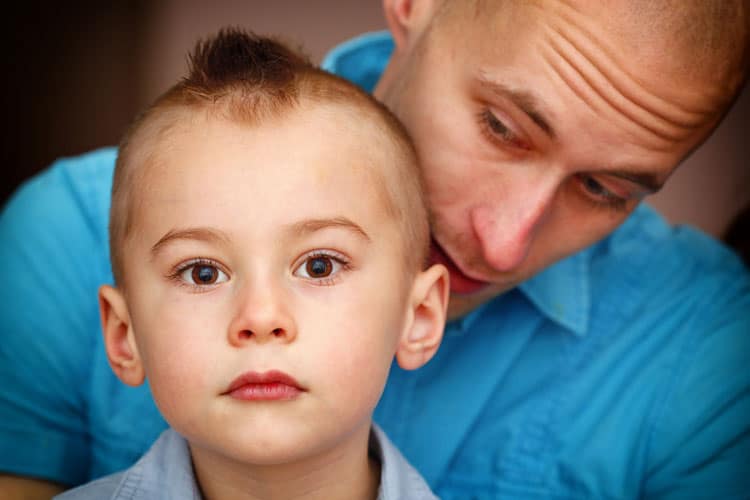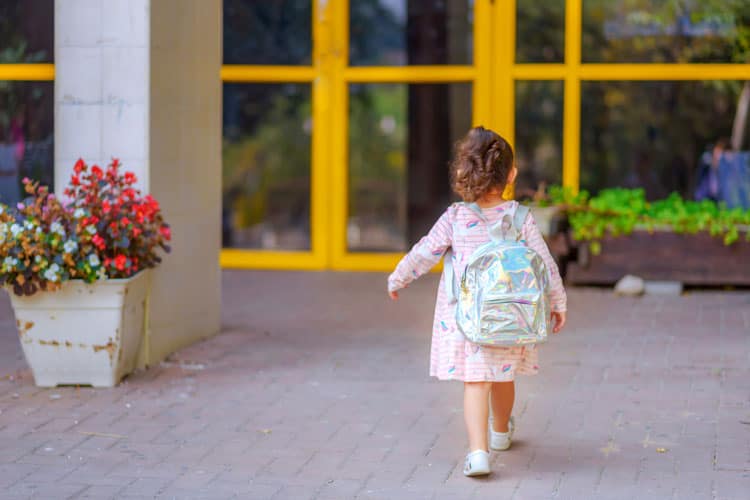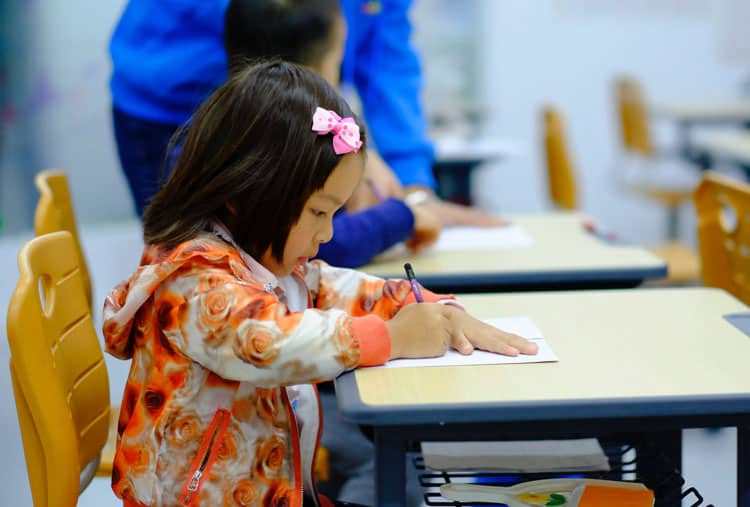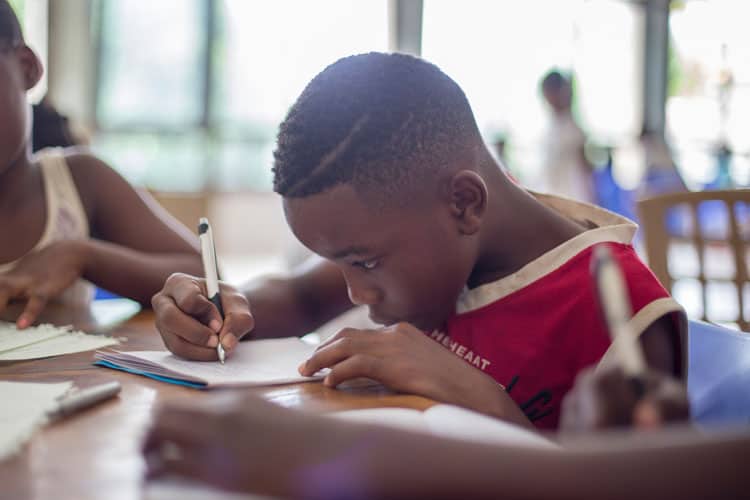We can all probably remember feeling those nervous butterflies in our stomachs as summer came to an end and a new school year approached. The transition into fall, with its scheduled days and new beginnings, is enough to make even the most happy-go-lucky child feel a bit uneasy (especially in the current state of COVID-19).
But what happens when back-to-school jitters for your child is much more than just a few anxious questions and a little trouble sleeping? Here are some ways you can help your little student achieve a confident beginning to the new school year and reduce back-to-school anxiety.
How to recognize the symptoms of back-to-school anxiety.

Children don’t always have the language to express how they are feeling, so be on the lookout for telling behaviors. Learn about anxiety and how to spot it in younger children. According to the Anxiety and Depression Association of America, anxiety in kids often manifests as symptoms such as “crying, tantrums, clinging, avoidance, headaches, and stomachaches.”
You might notice sleeplessness or another change in sleep patterns as well, especially as the first day of school gets closer. Your child might balk at any discussions or activities related to school. Also, be aware that your own mental health could be playing a role; watching your child grow and reach new academic milestones can be tough, especially if you had a negative experience with your own schooling. Anxiety is something to be aware of in yourself as a parent!
Listen closely to your child.

Find a quiet time to sit with your child and be their safe spot. Find out what it is that they are specifically anxious about when school starts. Is it separation anxiety? ]Fear about the workload? Some of the things they say might seem irrational, but the things they worry about are very real to them, so try to just listen and validate their feelings. Work together to find tangible solutions to the things that are making them feel nervous. It can also empower them to be reminded of other scary challenges they’ve faced and overcome, like the time they learned to ride a bike or have a sleepover. Help them to feel that they can attend school successfully, too! Finally, you may want to share some of your own positive experiences around school; favorite teachers, friends you met, field trips you enjoyed, and so on.
Get to know the place and the people.

It is often the unknown that makes a child feel that back-to-school anxiety, so help familiarize them with their new surroundings before the school bell rings. If there is an orientation, take advantage of this opportunity to check out the building. Learn about the playground, cafeteria, and your little one’s new classroom. Meet the teachers and the principal and find out their expectations for the first day of school. If appropriate, make them aware of any special concerns you have for your child’s beginning days. If an orientation is not an option you can still likely make an appointment to visit the school together to get a look at the space and hopefully meet some welcoming staff.
It is also helpful for parents to carefully read the school handbook and registration paperwork so that you are well-informed and able to make sure your student won’t get caught off-guard by any school policies and procedures.
Finally, friends make everything feel easier, so why not try and find out who will be in your child’s class and host a playdate. Older students will also feel less of that back-to-school anxiety once they connect with peers and compare schedules.
Prepare your child for the big day.

Now that your child is familiar with the school, it’s time to practice for the big day! Start following the new fall schedule at least a few days before it begins so that everyone’s internal clocks have a chance to get oriented. If your little student will be riding the bus, take a walk to the bus stop and imagine together what it will feel like to see that big yellow bus pull up.
Back at home, do some role playing to bring familiarity to the routines involved in a typical day. Have your child act out the situations they are worried about and come up with strategies for how they can respond. If they are brand new to the school routine, elementary school adjustment counselor Liesel Kelly from the Dennis-Yarmouth School District on Cape Cod, MA suggests having them take a break from their usual free play to lead them in structured play instead. “This introduces kids to the way a classroom works much of the time, with teachers leading activities and giving instructions,” she says.
Related articles:
- How To Be A Good Parent
- Is Your Toddler Getting Enough Physical Activity?
- Pros & Cons of Screen Time for Small Kids
Hit the stores and empower your kiddo to choose necessary school items.

It’s a timeless tradition to go shopping for a new backpack, school supplies, clothes, and shoes. Use this opportunity to give your kiddo a sense of control by letting them choose the items to whatever extent possible. Nothing brings a sense of pride to a small child like a special new belonging that they picked out for their first day! Back-to-school anxiety can be surprisingly stifled by a pair of shiny new sneakers.
…and go! The big day has arrived.

The big day has finally arrived! Help take pressure off of that first morning by setting out your child’s choice of outfit the night before. Have their backpack and lunch organized and ready to go so you aren’t worried about getting that done when you would rather focus on your child’s feelings about school. Go to bed on time and set the alarm clock a bit earlier than you normally would so that no one feels the stress of being rushed. Maybe even plan to make your child’s favorite breakfast to help the day feel special!
To reduce the likelihood of school refusal, talk positively about the day ahead and remind them of strategies you have developed together. Think about sending them off with some token (a good luck charm, bracelet, photo) that will remind them you are thinking about them and cheering them on. Make a plan for after school that involves a special treat and a chance to have a conversation about how things went. No matter what, remain calm and collected even though you will probably be feeling anxious for them. Your child is looking to you for assurance that nothing will go wrong on their first day back to school.
Following up with your child after the first day.

Hopefully all of your preparation will pay off and the first day of school will be a success, but don’t expect the feelings of back-to-school anxiety to disappear overnight even if things do go smoothly. You may have to help your child manage anxiety for a bit longer. Responsive Classroom authors Paula Denton and Roxann Kriete write that it takes the first six weeks of school for the classroom teacher to establish rules and expectations so that members of the class have a sense of order and predictability, which helps them to relax and focus on learning.
If these few weeks go by and your child is still showing strong signs of anxiety, it may be time to call in a professional. Start by contacting the school support staff, such as a psychologist or guidance counselor. You might also talk to your child’s health care provider about the signs of anxiety you are seeing. There may be something going on that only outside help can get to the bottom of, such as any related disorder(s), a learning disorder, or even a bully.
Literature resources for back-to-school anxiety.

Younger children can better visualize a new situation and reduce back-to-school anxiety if they have been exposed to it through a storybook. Here are some great reads about the excitement (and worries!) of back-to-school time.
- School’s First Day of School by Adam Rex
- Look Out Kindergarten, Here I Come! by Nancy Carlson
- The Night Before Kindergarten by Natasha Wing
We hope these tips help your child better adjust to the new school year with ease. Do you have tips to share about getting your child through back-to-school anxiety, fears and worries? Tell us in the comments below!

Lisa Holmes lives in Wellfleet, MA with her husband, toddler and infant. She is a BabyQuip Quality Provider and loves welcoming travelers to Cape Cod. She works as an elementary school teacher, which gives her the opportunity to enjoy lots of time at the beach during her summer vacations!



Some of these tips are helpful for parents’ anxiety too!
Any tips for the parents with that dreaded first of PreK!
I’m stressed and trying not to show it!
It’s remote learning for at least the first quarter of Kindergarten here in Madison, WI. So sad for my little one. I hope that she gets to have the back to school experience.
It’s still a waiting game. In South Florida a hybrid option is being considered. Students would learn online 2/3 days a week and be in the classroom the other days.
The anxiety never ends. My kids are anxious about going back to college and whether they’ll be able to, given the uncertainty with COVID.
Great article! Definitely will share these tips!
Great tips! My little boy has pretty bad anxiety about covid. I’m gonna try these things cause I think they will go back face to face.
These poor kids. They need the socialization. It’s been so long!
Great tips and things to look out for. Especially with COVID. Anxiety is high, as a parent right now, trying to make the best decisions for school age children.
The schools here (Michigan) are pretty certain the kids are going back but it’s not definite yet. I told my daughter and she’s been acting out bad. I didn’t put the two things together until reading this article. I’m goign to try to talk to her more about what’s going on and if she thinks its related to coronavirus. THANK YOU!!
What a way to have to start school. Fear is high. I can see how kids would act out when thinking about having to go back to school in this day and age of COVID-19.
I love the walking to the school bus in prep for the big day tip! My daughter is going to start 1st grad this fall and this will be her first experience with the bus lol!
I always let my kids pick out their own school supplies. They are the ones who have to use them!!!!!! They love doing it each year.
Great tips, great article. thank you for sharing it.
How many of you konw if your kids are actually going back to school. Our schools haven’t announced it yet.